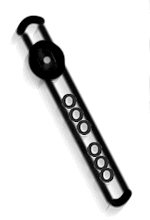So, you just got your first flute, but you don't know how to put it together. Keep reading to learn how.
_______________________________________
1 To put your flute together, we first need to know the names of the three parts of the flute: 1) Head joint, 2) Body and 3) Foot joint.
3 Locate the Body of the flute.
4 Locate the Foot Joint.
5 Pick up the Body of the flute. Be careful to pick it up by the barrel (see picture) because we want to avoid grasping the flute by the key work.
6 While holding your flute by the barrel, pick up the Head Joint. Insert the open end of the Head Joint into the barrel using a twisting motion.
7 While continuing to hold your flute by the barrel, pick up the Foot Joint (see picture). Carefully insert the Body of the flute (the side opposite the barrel) into the Foot Joint. See picture to know which end of the Foot Joint attaches to the Body.
Also notice in this photograph that the Foot Joint has 3 keys. Many flutes only have 2 keys on the Foot Joint. Do not be alarmed if your flute only has 2 keys. This is perfectly normal.
8 Now, let's check the alignment of the flute.
 9 Twist the Head Joint (still holding the Body by the barrel) to align the center of the hole in the Head Joint with the center of the key work on the Body as shown in the picture.
9 Twist the Head Joint (still holding the Body by the barrel) to align the center of the hole in the Head Joint with the center of the key work on the Body as shown in the picture.
 9 Twist the Head Joint (still holding the Body by the barrel) to align the center of the hole in the Head Joint with the center of the key work on the Body as shown in the picture.
9 Twist the Head Joint (still holding the Body by the barrel) to align the center of the hole in the Head Joint with the center of the key work on the Body as shown in the picture. 10 Align the Foot Joint with the key work of Body as shown in the picture.
11 The rod on the Foot Joint should be rotated slightly in from the edge of the keys on the Body.
11 The rod on the Foot Joint should be rotated slightly in from the edge of the keys on the Body.
_______________________________________________
Tips
Be careful not to hold the flute by the key work to avoid costly repairs.
________________________________
Additional Resources


















